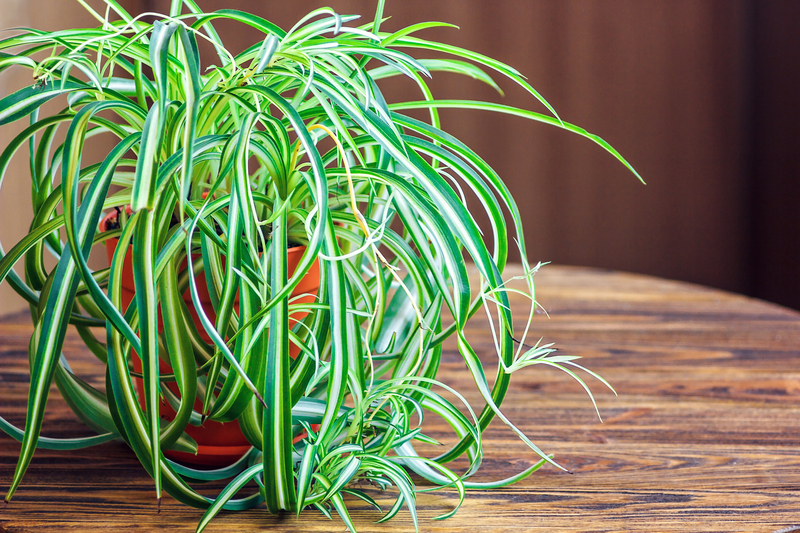Transform Cityscapes with the Art of Vertical Gardening
Posted on 03/09/2025
Transform Cityscapes with the Art of Vertical Gardening
The modern cityscape is dynamic, constantly evolving to accommodate more people, vehicles, and technologies. However, amid relentless urbanization, cities often face a dire lack of greenery and biodiversity. Luckily, innovative solutions like vertical gardening are steadily transforming concrete jungles into lush, livable spaces. In this comprehensive guide, we'll delve into how the art of vertical gardening can breathe new life into urban environments, exploring its benefits, design principles, popular plant choices, and tips for implementation. Whether you are an enthusiastic green thumb or an urban planner, understanding the power and potential of vertical gardens is essential for shaping vibrant, sustainable cityscapes.

What is Vertical Gardening?
Vertical gardening, also referred to as living walls or green walls, involves growing plants on vertical surfaces rather than traditional horizontal beds. This innovative gardening method maximizes the use of vertical space, making it a perfect solution for cities where land is scarce but walls are plentiful. Urban buildings, fences, and even indoor spaces can become thriving gardens, offering a fresh and beautiful take on urban greening.
- Living Walls: Structures where plants grow in specialized containers or panels attached to walls.
- Trellises and Climbing Gardens: Support climbing plants like ivy, jasmine, and wisteria, creating natural green drapes.
- Modular Vertical Gardens: Systematic arrangements of pots or planters to build layered gardens on walls.
Why Vertical Gardens Matter in Today's Urban Landscape
The integration of vertical gardens into urban environments is more than just a trend--it's a proactive approach to improving the quality of life. As cities grapple with the challenges of pollution, the urban heat island effect, and declining biodiversity, vertical gardening offers numerous practical, aesthetic, and ecological solutions.
Key Benefits of Vertical Gardening for Urban Transformation
1. Beautification of the Urban Aesthetic
Vertical gardens turn ordinary, often bland, city walls into stunning visual landmarks. The vibrant colors, diverse textures, and ever-changing compositions introduce a natural element that softens hard architectural lines and enlivens the city experience.
- Public spaces such as plazas, malls, and transit stations become more inviting.
- Residential and commercial buildings gain visual appeal, increasing property value and tenant satisfaction.
- Landmarks: Iconic living walls can become popular attractions, adding to a city's unique identity.
2. Improving Air Quality
Urban air is often clogged with pollutants and particulate matter. Vertical gardening can be a natural air purifier:
- Plants absorb carbon dioxide and many toxins, releasing fresh oxygen.
- Dense foliage traps dust, heavy metals, and other airborne particles.
- Microbial activity in the soil and roots can break down some pollutants.
3. Mitigating the Urban Heat Island Effect
Cities tend to be significantly hotter than surrounding rural areas--a phenomenon known as the urban heat island effect. Vertical gardens combat this by:
- Providing natural insulation to buildings, reducing heat absorption.
- Cooling the air through transpiration, where plants release moisture.
- Reducing the need for energy-intensive air conditioning.
4. Enhancing Urban Biodiversity
Through thoughtful plant selection, vertical gardens reintroduce habitats for birds, bees, butterflies, and beneficial insects that are often missing in urban environments. Introducing native plant species and flowering plants can attract pollinators and support ecological health.
5. Efficient Use of Limited Space
Perhaps the greatest advantage is the ability to "grow up" rather than "out." Vertical gardening enables:
- Productive gardens in tiny apartments, balconies, rooftops, and offices.
- The cultivation of edible plants for urban farming and community gardens.
- Transforming underutilized vertical spaces into productive, lively green areas.
6. Psychological and Social Benefits
The presence of greenery has been shown to lower stress, boost mental health, and foster community wellbeing. Vertical gardens create spaces where people can connect with nature even in the heart of the city, leading to:
- Improved mood and productivity.
- More enjoyable and restorative urban environments.
- Educational opportunities for city dwellers to learn about sustainability and horticulture.
Design Principles for Stunning Urban Vertical Gardens
To truly transform a cityscape with vertical gardening, design and execution are key. Successful installations consider aesthetic, ecological, and maintenance factors. Here's how to create impactful green walls:
1. Location and Accessibility
- Choose vertical surfaces with ample sunlight or shade as needed for your plants.
- Ensure the wall can support the weight of the garden.
- Prioritize locations where high visibility and community interaction are possible.
2. Structural and Irrigation Systems
- Use robust frames or panels designed to anchor securely to existing walls.
- Install automated drip or hydroponic irrigation systems for low-maintenance care.
- Incorporate water catchment and recirculation options to conserve water.
3. Plant Selection and Diversity
- Mix foliage, flowering, and edible plants for year-round interest.
- Choose species well-suited for the local climate and site conditions (lighting, wind, rain).
- Integrate native species to attract local wildlife and promote ecological balance.
- Consider vertical layers: taller plants on top, trailing plants cascading below.
4. Maintenance Planning
- Factor in ease of access for plant care, pruning, and irrigation system checks.
- Select hardy, disease-resistant plants to minimize maintenance.
- Schedule routine fertilizer, pest control, and system inspections.
5. Aesthetic Cohesion
- Use color schemes, foliage patterns, and plant textures to create living art.
- Coordinate with surrounding architecture for a harmonious look.
Popular Plant Choices for City Vertical Gardens
The key to a thriving vertical garden is picking the right greenery. Here are some tried-and-true plant groups perfect for vertical installations:
- Succulents and Cacti: Low-maintenance, drought-tolerant, and visually striking.
- Ferns: Add lushness and texture, ideal for shaded walls.
- Tropical foliage plants: Philodendrons, pothos, and monsteras create dense, vibrant canopies.
- Herbs and Edibles: Basil, mint, strawberries, and kale are both practical and decorative.
- Flowering perennials: Begonias, impatiens, and petunias bring continuous color.
- Vines and climbers: English ivy, jasmine, and wisteria can trail or climb gracefully.
It's wise to select species with similar light and water requirements for easier maintenance and optimal growth.
Famous Examples of Vertical Gardening Transforming Global Cities
Cityscapes worldwide have been dramatically altered and enhanced by innovative vertical gardens. Here are a few inspirational projects:
- One Central Park, Sydney: The tower's entire facade bursts with greenery, featuring over 35,000 plants as part of a sustainable mixed-use development.
- Musee du Quai Branly, Paris: Renowned botanist Patrick Blanc's living wall installation covers 800 square meters, showcasing hundreds of plant species.
- Edificio Santalaia, Bogota: This 9-story residential building is home to the world's largest vertical garden, demonstrating immense biodiversity and significant air purification.
- The Green Wall at The Athenaeum, London: A breathtaking wall of foliage that has become a living, breathing icon in the heart of the city.
These stunning examples illustrate how the art of vertical gardening can reimagine city architecture and inspire sustainable urban renewal globally.
How to Start Your Own Vertical Garden in the City
Ready to bring the charm of living walls to your own urban space? Here's a step-by-step guide:
Step 1: Analyze Your Space
- Measure available wall or fence area.
- Observe how much direct sunlight or shade the area receives.
- Verify the structural strength of your chosen surface.
Step 2: Choose a System
- DIY pocket panels: Affordable and flexible for small spaces.
- Modular kits: Perfect for beginners with easy installation.
- Custom hydroponic or irrigation-based systems: Ideal for larger or more complex gardens.
Step 3: Select Plants
- Research plants that thrive in your specific microclimate.
- Combine edibles, evergreens, and seasonal flowers for visual diversity and functionality.
Step 4: Assemble and Plant
- Secure the frame or panel to your chosen surface.
- Fill planting pockets or containers with quality potting mix.
- Arrange plants according to light and water needs.
Step 5: Maintenance
- Monitor for pests, nutrient deficiencies, and irrigation issues.
- Prune and trim regularly for healthy development.
- Fertilize periodically to encourage lush growth.
By following these basic steps, you can transform your urban environment with vertical gardening, contributing to a greener, healthier, and more attractive city.
Challenges and Considerations in Vertical Gardening
While the art of vertical gardening offers myriad rewards, there are several practical challenges to consider:
- Weight Load: Soil, plants, and water can be heavy. Ensure your wall can bear the weight before installation.
- Water Management: Overwatering, leakage, or insufficient drainage can cause problems in both indoor and outdoor systems.
- Maintenance: Living walls require regular care, including watering, trimming, and replacing plants when necessary.
- Initial Investment: Quality vertical gardening systems can be costly to set up, though they save money and energy in the long term.
- Plant Selection: Picking inappropriate species can lead to plant failure and higher maintenance needs.
With thoughtful planning and proper resources, these obstacles are easily surmountable, paving the way for successful and enduring green walls.

The Future: Greener and More Livable Cities with Vertical Gardening
The rise of vertical gardening marks a new paradigm in urban landscaping, bringing nature back into some of the most densely built environments. With the integration of vertical green spaces, cities worldwide can look forward to reduced pollution, improved biodiversity, energy savings, and unmatched beauty.
- Smart technology will drive automated irrigation and monitoring, lowering maintenance costs and improving sustainability.
- City-wide initiatives are set to make vertical gardens common on public buildings, infrastructure, and residential complexes.
- Innovative materials and design will allow larger and more creative installations.
- Community involvement will empower residents to participate in greening their neighborhoods, fostering a collective sense of stewardship.
Conclusion: Embrace the Art of Vertical Gardening to Transform Cityscapes
The journey of transforming cityscapes with the art of vertical gardening is both inspiring and achievable. By leveraging innovative living walls, every urban resident, architect, planner, or business owner can play a part in redefining the urban experience. From boosting air quality to offering creative outlets and improving community health, the advantages are irrefutable. Start your vertical gardening journey today and help turn your city into a thriving oasis of green for generations to come.

